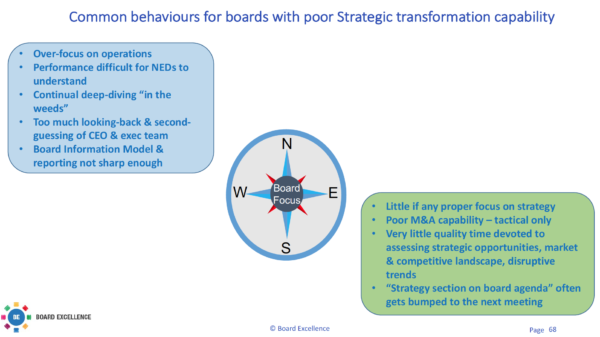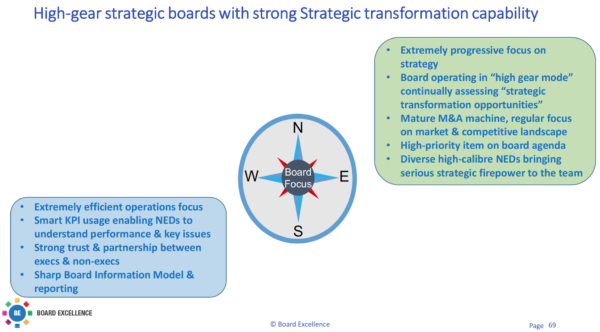A board member recently contacted me for support and inspiration to help his board team address a long-standing challenge around how his board handles the area of strategy and development of strategic transformational thinking. He indicated that while there is quite an experienced hard-working board team in place and their company has been a major player for many years in their market sector, their marketplace is now changing at such an alarming pace that standing still is simply not an option and while they have had a very steady conservative approach to strategy until now, the board and executive team need to step up now and identify some radical & left-field strategic options in response to some major moves by competitors, new entrants with disruptive technology and business models as well as significant changes within their customers.
The struggle this board is experiencing in terms of their ability to drive genuinely strategic transformational thinking of how to position their organisation for the years ahead is shared by the majority of boards. Up to recent years, the strategic pressure on many organisations was very manageable by a solid board team. Utilising an annual strategy away day and a reasonably regular discussion on strategic options was more than sufficient to help guide a well-run organisation. This traditional board model for handling strategy however is breaking down as organisations are faced with incredible levels of change and disruption in their marketplace ranging from significant changes in customer behaviours/needs, technology disruption such as AI & Blockchain, radical new business models, increased competition and a dramatic reduction in barriers to entry for new entrants. Many private equity firms have commented to me that in the case of their out-performing exits, there was a strong pattern of highly effective board teams who continually demonstrated the capability of strategic transformational thinking to identify, assess and grasp game-changing opportunities either in M&A, new product direction or radical business models. The scale and pace of change in the financial services sector globally right now is a very good example where challenger banks and a whole new wave of disruptive well-funded fintech entrants are making steady progress as traditional banks grapple with the incredible challenges of transforming a legacy IT infrastructure and their organisations.
How many board teams mis-handle the strategy area and struggle to drive major strategic transformational thinking is highlighted here in Figure 1 below, an extract from our board best practices workshop. I find the analogy of a “board focus compass” helps to understand the different approaches board teams take to the strategy area.

In this model, the board has a strong comfort zone in operations and numbers spending the vast majority of the board meeting in continual “deep-diving in the weeds”. In many cases, the board information model is not sharp enough to help the non-execs get a very clear and accurate picture of the organisation performance and key issues which then leads to a significant level of questioning and in some cases second-guessing of the CEO and exec team. What this then leads to is the board spending very little quality time on the strategy area and driving high-levels of genuine strategic thinking and discussion of the market landscape, threats, opportunities etc. A common characteristic I have seen in these boards are non-execs who have a strong comfort zone in the financial numbers and have very little if anything to add in the strategy area. Boards in this mode find it very difficult to get into a zone where serious strategic transformation options get identified and where radical progressive and left-field thinking is encouraged. In many cases, there is simply not the diversity of thinking styles and strategic firepower around the board table to drive a radical cold objective view of the market landscape both in terms of threats and opportunities. This also highlights a common problem whereby many board teams have not refreshed their non-exec director positions to bring in new fresh blood with the skillsets and strategic capability to help look at the unfolding landscape with genuine fresh eyes and not be chained by the strategy and approach which in many cases has served the organisation quite successfully up to now.
A number of boards however have developed the capability to operate in “high-gear strategic mode” and the capacity for “big thinking” around the board table. This mode is highlighted in Figure 2 below ;

The common characteristics of “high-gear strategic boards” are as follows ;
Strong orientation of their “board focus compass” to the strategy area
These board teams have a very conscious approach to ensuring an extremely efficient operations and performance focus to enable the board spend a significant portion of its time and focus on the strategy area – identifying strategic options, understanding current strategy execution, sharp assessment of the competitive and market landscape as well as the ability to react quickly and effectively to sudden/un-expected major changes in the market and/or opportunities that present themselves.. The board chair working closely with the CEO has a particular key leadership role in ensuring this focus.
Outstanding levels of trust and partnership between execs and non-execs
To enable a board to have a major strategic focus, it requires an environment whereby the board and non-exec directors can properly and efficiently discharge their critical oversight responsibilities of the performance of the CEO and exec team, overall operations, financial health and risk management for the organisation etc. In highly effective high-performing board teams this is enabled by an outstanding partnership between execs and non-execs which enable the non-execs to achieve this in a very efficient and effective manner enabling the board team to devote a significant portion of the board time to the strategy area.
High-quality Board Information Model
Highly effective board teams realise and appreciate the importance of a very sharp board information model in enabling a very efficient understanding of operations and performance to then enable the board team to devote a significant portion of the board team bandwidth to the strategy area. When combined with very thorough preparation by the non-execs for the board meeting, highly effective executive summaries, absolute openness by the CEO/Execs on the critical serious issues and smart use of “consent agendas”, this avoids the energy-sapping “diving into the weeds of operations & finance” and enables the board team to focus on significant value-adding strategic activities.
CEO & Executive team enabling non-exec directors play a major role in strategy
In highly strategic board teams, all of the board members have an active role in the strategy area. In most cases, the CEO and executive team continue to drive the initial strategic options but astute CEOs and board chairs will ensure that all of the board members are heavily involved in assessing, challenging and debating the various strategic options. The days of boards carrying a non-exec board member with absolutely nothing to contribute strategically are fast diminishing. Progressive CEOs and board chairs also challenge the non-exec board members to bring their own strategic and left-field thinking to the table. This is where high-calibre independent non-execs with deep industry knowledge and expertise can bring unique value to the table.
High-calibre non-execs with the firepower to enable strategic transformational thinking
In a modern organisation of any scale, the sheer demands on the CEO & executive team to deliver on monthly/quarterly commitments while dealing with the daily cut and thrust often means that CEOs find it very challenging to have the time to step back, have the bandwidth to deeply study the dynamic fast-changing market environment and fully understand the nature and scale of all the disruptive forces at play. In most cases they are simply too close to their business and in many cases too closely wedded to their current product/service portfolio and business model to be able to step back to undertake radical left-field thinking which could involve the slaying of some existing sacred cows as well as an organisation undertaking major strategic steps outside of their comfort zone ( larger M&A opportunity than usual, new disruptive business model, shedding of legacy business unit, adoption of disruptive new technology etc. ). This is where genuine high-calibre independent non-execs with deep industry knowledge and expertise can bring huge value to a board team and working closely with the CEO and exec team, help generate “big ambitious transformative thinking” around the board table. There are also cases where a board brings in experienced non-exec directors from outside of their industry sector to provide fresh disruptive thinking ( a common example would be traditional sector company boards who have brought on a heavyweight technology expert to help them navigate the potential options of utilising Artificial Intelligence, big data etc. )
Diversity of thinking styles and its impact on strategic thinking
One of the areas that a lack of diversity around the board team impacts is the ability of the board to genuinely identify and properly consider radical left field and transformative strategic opportunities. In recent years, there have been many traditional companies who have lost their way and seen their traditional strong market position severely damaged. I imagine that in many of these situations, the board team either completely missed the scale of the threats from radical business model changes and disruptive market entrants or in many cases refused to properly open their minds and have the level of un-biased strategic debate to not only see and understand the threats looming but also grasp the opportunities the market disruptive forces are actually providing. In some cases, a number of boards stubbornly refused to refresh their non-exec directors and not realizing that while those non-exec directors played a critical role up to now, their skillsets may not be sufficient for the organisation’s next phase of evolution. My experience of the most progressive board teams is that the board chair and CEO are continually looking to have an optimum balance of high-calibre “generalist” non-exec directors with great overall business skills, experience & judgement and outstanding non-exec directors with deep industry knowledge, expertise and really current with and ideally ahead of the market.
Board team’s openness to external independent thinking
One of the characteristics I have seen over the years in highly strategic board teams is a strong emphasis on continually ensuring a genuine stream of independent reports, market assessments, competitor and market analysis is included in the board information model and overall board stream of thinking that is independent of the executive team. These board teams are also very open to bringing in external independent experts to both board meetings and strategy away days ranging from the traditional larger consultancy players to individual and small boutique firms to help the board understand the unfolding landscape, help get a very fresh view on the competitive landscape, pending developments in the regulatory landscape as well as help the board team both identify serious threats as well as major strategic opportunities.
Summary – enabling strategic transformational thinking within your board team
The genie is out of the bottle in the majority of sectors and if anything the pace and rate of change and market disruption will only increase and with that, every board team, irrespective of the current scale and market position of the company/organisation, will need to be on the front-foot and ensuring that it has the capability to not only have a strong strategy focus but the capability for genuine strategic transformational thinking to help the organisation be optimally prepared for the scale of threats and disruption that exists as well as the incredible opportunities it is providing to organisations with the ambition and capability to spot and take advantage of these opportunities. Many board teams are in serious need of refreshing the ranks of their non-executive directors to ensure that new blood and additional strategic firepower is available to the board team to ensure it is absolutely on its toes and equipped for the years ahead. Complacency and a lack of diversity of thinking styles around a boardroom table is a very dangerous combination particularly for organisations facing major disruption and new/increasing competition in their market environment. Even quite experienced board teams can drift into bad habits and over-focus on operations and the ebb and flow of the existing organisation. The shareholders and stakeholders in each organisation are placing a critical responsibility in their board teams to not only safeguard their interests but importantly add major strategic value by identifying, assessing and where appropriate grasping transformational opportunities that will ensure long-term sustainable success for the organisation’s shareholders and stakeholders.
Kieran Moynihan is the managing partner of Board Excellence ( https://boardexcellence.com) – supporting boards & directors in Ireland, UK and internationally excel in effectiveness, performance and corporate governance.
Think your business could benefit from our services and expertise? Get in touch today to see how we can support your board excel for its shareholders, employees and stakeholders.

